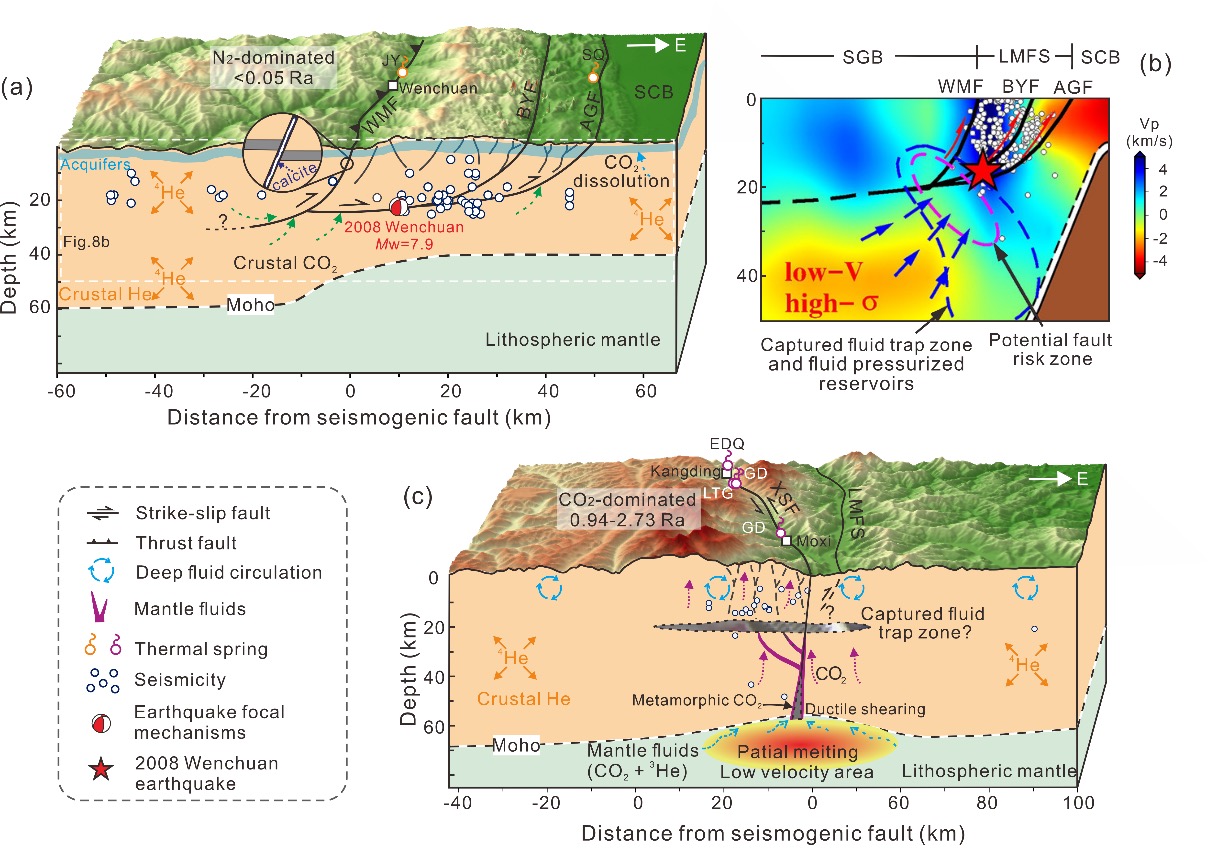Degassing of deeply-derived fluids (e.g., He and CO2) prevails along seismically active faults in the Tibetan Plateau, where potential insights into seismogenesis through tectonic degassing remain less understood. This study presents a quantitative geochemical study on hydrothermal gases from a Y-shaped active fault system in the eastern Tibetan Plateau, aiming to delineate how tectonic degassing (e. g., fluid origin and transport) may be linked to seismogenic processes in continental collision settings. Our results show that (i) vigorous degassing of mantle- and crustal-derived CO2-rich fluids (3He/4He = 0.94–2.73 Ra, where Ra = air 3He/4He; δ13CCO2 = −8.9 to −2.6‰) dominates the axis zone of the Y-shaped active fault system (Fig. 1), while (ii) crustal fluid inputs become more prevalent along its NW branching fault (3He/4He = 0.03–0.62 Ra; δ13CCO2 = −8.9 to −0.2‰) and the NE and SE branches (3He/4He = 0.01–0.07 Ra; δ13CCO2 = −17.3 to −5.2‰). Localized mantle melting and metamorphic decarbonization likely produce the CO2-rich fluids, which could account for significantly higher CO2 flux in the axis zone (9.66 × 109 mol/yr) than along the NW branch (1.25 × 109 mol/ yr). The well-correlated 3He/4He ratios and slip rates suggest a genetic model in which the uprising CO2-rich fluids may facilitate rapid fault slip and enhanced fault permeability, which could in turn lead to efficient mantle He degassing. Taking the fluid origin and transport, CO2 fluxes, and regional seismicity together, we suggest that the deeply-derived CO2-rich fluids may contribute to overpressure involved in seismogenic processes of the Y-shaped active fault system (Fig. 2). The 2022 Ms 6.8 Luding earthquake is a case of seismicity triggered by deep fluids.

Fig. 1. Correlation of helium isotopes with S-wave velocity anomalies at a depth of 70 km in the intersection zone of the LMFS, YGXFS, and ANFS in the Y-shaped fault system.

Fig. 2. Conceptual model of deeply-derived fluid migration and tectonic interaction of the Y-shaped active fault system in the eastern Tibetan Plateau
Article information:
Liu W., Zhang M*., Chen B., Liu Y., Cao C., Xu W., Zheng G., Zhou X., Lang Y-C., Sano Y., Xu S*. 2023. Hydrothermal He and CO2 degassing from a Y-shaped active fault system in eastern Tibetan Plateau with implications for seismogenic processes. Journal of Hydrology, 620: 129482
https://doi.org/10.1016/j.jhydrol.2023.12948